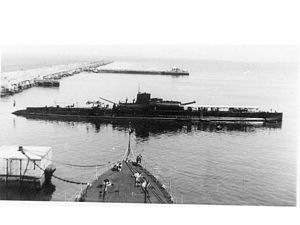The Surcouf was the largest submarine in the World when she was launched. Displacement; 3250/4,318 t surfaced/submerged, length; 110m, Range; surfaced 10,000/6,800nm at 10/13.5 kts, submerged 70/60nm at 4.5/5 kts , two 203mm guns and 10 torpedo tubes, 4 bow, 3 in two swivel mountings. She carried anti-aircraft machine guns and a light spotter aircraft in a water-tight hold. The submarine is shown here in the harbour at Casablanca, note the Besson MB.411 floatplane aft of the bridge/hangar structure and the crane used for launching and recovery, A.A. machine guns just aft of the conning tower. The rangefinder is aligned fore and aft just forward of the bridge.
|
 |